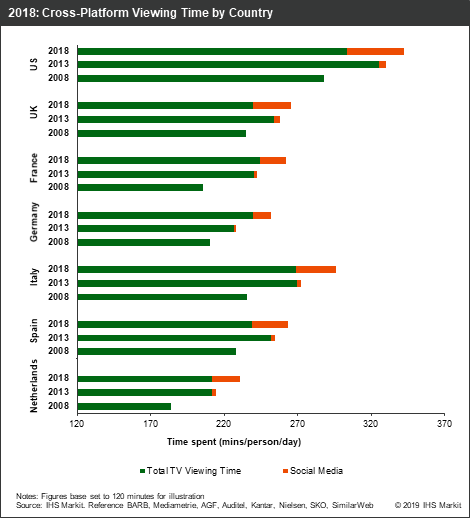A new study from IHS Markit illustrates how television viewers are increasingly turning to video streaming services such as Netflix as their only source of TV entertainment.

The study reports how “total cross-platform viewing times” in the U.S. and major European markets are declining, with viewers increasingly substituting traditional TV channels for “non-linear platforms”.
IHS Markit said the average daily video viewing time in the U.S., the U.K., France, Germany, Italy, Spain and the Netherlands stood at 273.7 minutes per person per day in 2018, compared to the peak of 284.3 minutes per person per day in 2013. Back then, linear TV viewing accounted for 87% of those minutes, but today it makes up just 67%.
“The decline in minutes suggests a shift in viewing habits as non-linear becomes the television format of choice for more viewers,” IHS Markit said.
Where as before, non-linear TV was seen as an additive to regular TV channels, it’s now becoming more of an alternative for many viewers, the analyst firm believes.

Not surprisingly, IHS Markit said the most popular kind of non-linear TV is “online long-form video”, which is defined as content that has a duration of 15 minutes or longer. Services such as Netflix, Amazon Prime and so on, in other words. In 2018, the average viewing times for this type of content grew by six minutes per person per day compared to the year before. This finding backs up earlier research that shows consumers have a growing preference to sign up for video streaming services when looking for new content to watch, the analyst firm said.
Also interesting is the growth of “social video”, which added more than 8 minutes per person per day in the last year. Facebook is the primary reason for this, thanks to its shift to a more “video-centric” strategy across its main platforms, which include Instagram and WhatsApp as well as Facebook itself.
One reason for social video’s growth is likely the growing prominence of video casting devices such as Google’s Chromecast. IHS Markit found that 28% of viewers in the U.S., U.K. and Germany cast video content from a mobile device to their TVs at least once a month, with this figure rising to 46% in the 18 to 24-years old age group.
“Mobile devices have become a key area of growth in terms of video consumption, particularly out of the home, as data plans become more affordable and screen sizes increase,” Fateha Begum, principal research analyst at IHS Markit, said in a statement. “Connected living room devices, however, present new opportunities for social platforms to reach wider audiences particularly as consumer appetite for short-form viewing improves”